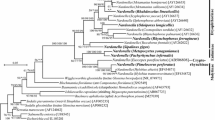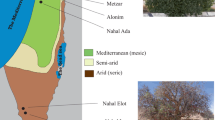Abstract
The genus Arsenophonus (Gammaproteobacteria) is comprised of intracellular symbiotic bacteria that are widespread across the arthropods. These bacteria can significantly influence the ecology and life history of their hosts. For instance, Arsenophonus nasoniae causes an excess of females in the progeny of parasitoid wasps by selectively killing the male embryos. Other Arsenophonus bacteria have been suspected to protect insect hosts from parasitoid wasps or to expand the host plant range of phytophagous sap-sucking insects. In addition, a few reports have also documented some Arsenophonus bacteria as plant pathogens. The adaptation to a plant pathogenic lifestyle seems to be promoted by the infection of sap-sucking insects in the family Cixiidae, which then transmit these bacteria to plants during the feeding process. In this study, we define the specific localization of an Arsenophonus bacterium pathogenic to sugar beet and strawberry plants within the plant hosts and the insect vector, Pentastiridius leporinus (Hemiptera: Cixiidae), using fluorescence in situ hybridization assays. Phylogenetic analysis on 16S rRNA and nucleotide coding sequences, using both maximum likelihood and Bayesian criteria, revealed that this bacterium is not a sister taxon to “Candidatus Phlomobacter fragariae,” a previously characterized Arsenophonus bacterium pathogenic to strawberry plants in France and Japan. Ancestral state reconstruction analysis indicated that the adaptation to a plant pathogenic lifestyle likely evolved from an arthropod-associated lifestyle and showed that within the genus Arsenophonus, the plant pathogenic lifestyle arose independently at least twice. We also propose a novel Candidatus status, “Candidatus Arsenophonus phytopathogenicus” novel species, for the bacterium associated with sugar beet and strawberry diseases and transmitted by the planthopper P. leporinus.





Similar content being viewed by others
References
Alison PG (2003) Epidemiology meets evolutionary ecology. Trends Ecol Evol 18:132–139
Arneodo JD, Bressan A, Lherminier J, Michel J, Boudon-Padieu E (2008) Ultrastructural detection of an unusual intranuclear bacterium in Pentastiridius leporinus (Hemiptera: Cixiidae). J Inver Pathol 97:310–313
Bai X, Zhang J, Ewing A, Miller SA, Jancso Radek A, Shevchenko DV, Tsukerman K, Walunas T, Lapidus A, Campbell JW, Hogenhout SA (2006) Living with genome instability: the adaptation of phytoplasmas to diverse environments of their insect and plant hosts. J Bacteriol 188:3682–3696
Bové JM, Garnier M (2002) Phloem-and xylem-restricted plant pathogenic bacteria. Plant Science 163:1083–1098
Bressan A, Sémétey O, Nusillard B, Clair D, Boudon-Padieu E (2008) Insect vectors (Hemiptera: Cixiidae) and pathogen types associated with syndrome “basses richesses” disease of sugar beet in France. Plant Disease 92:113–119
Bressan A, Arneodo JD, Simonato M, Haines WP, Boudon-Padieu E (2009) Characterization and evolution of two bacteriome-inhabiting symbionts in cixiid planthoppers (Hemiptera: Fulgoromorpha: Pentastirini). Environ Microbiol 11:3265–3279
Bressan A, Sémétey O, Arneodo J, Lherminier J, Boudon-Padieu E (2009) Vector transmission of a plant pathogenic bacterium in the Arsenophonus clade sharing ecological traits with facultative insect endosymbionts. Phytopathology 99:1289–1296
Chiel E, Gottlieb Y, Zchori-Fein E, Mozes-Daube N, Katzir N, Inbar M, Ghanim M (2007) Biotype-dependent secondary symbiont communities in sympatric populations of Bemisia tabaci. Bull Entomol Res 97:407–413
Dale C, Beeton M, Harbison C, Jones T, Pontes M (2006) Isolation, pure culture, and characterization of “Candidatus Arsenophonus arthropodicus,” an intracellular secondary endosymbiont from the hippoboscid louse fly Pseudolynchia canariensis. Appl Env Microbiol 72:2997–3004
Danet J-L, Foissac X, Zreik L, Salar P, Verdin E, Nourrisseau JG, Garnier M (2003) “Candidatus Phlomobacter fragariae” is the prevalent agent of marginal chlorosis of strawberry in French production fields and is transmitted by the planthopper Cixius wagneri (China). Phytopathology 93:644–649
Darby AC, Choi JH, Wilkes T, Hughes MA, Werren JH, Hurst GDD, Colbourne JK (2010) Characteristics of the genome of Arsenophonus nasoniae, son-killer bacterium of the wasp Nasonia. Insect Mol Biol 19:75–89
Davis MJ, Ying Z, Brunner BR, Pantoja A, Ferwerda FH (1998) Rickettsial relative associated with papaya bunchy top disease. Curr Microbiol 36:80–84
Duron O, Bouchon D, Boutin S, Bellamy L, Zhou L, Engelstadter J (2008) The diversity of reproductive parasites among arthropods: Wolbachia do not walk alone. BMC Biol 6:27
Edgar RC (2004) MUSCLE: multiple sequence alignment with high accuracy and high throughput. Nucleic Acids Res 32:1792–1797
Erickson DL, Waterfield NR, Vadyvaloo V, Long D, Fischer ER, French-Constant R, Hinnebusch BJ (2007) Acute oral toxicity of Yersinia pseudotuberculosis to fleas: implications for the evolution of vector-borne transmission of plague. Cellular Microbiol 9:2658–2666
Fukatsu T, Watanabe K, Sekiguchi J (1998) Specific detection of intracellular symbiotic bacteria of aphids by oligonucleotide-probed in situ hybridization. Appl Entomol Zool 33:461–472
Gatineau F, Jacob N, Vautrin S, Larrue J, Lherminier J, Richard-Molard M, Boudon-Padieu E (2002) Association with the syndrome “basses richesses” of sugar beet of a phytoplasma and a bacterium-like organism transmitted by a Pentastiridius sp. Phytopathology 92:384–392
Gherna RL, Werren JH, Weisburg W, Cote R, Woese CR, Mandelco L, Brenner R (1991) Arsenophonus nasoniae, genus novel, species novel, causative agent of son killer trait in the parasitic wasp, Nasonia vitripennis. Int J Syst Bacteriol 41:563–565
Gotoh T, Noda H, Ito S (2007) Cardinium symbionts cause cytoplasmic incompatibility in spider mites. Heredity 98:13–20
Guindon S, Gascuel O (2003) A simple, fast, and accurate algorithm to estimate large phylogenies by maximum likelihood. System Biol 52:696–704
Hansen AK, Jeong G, Paine TD, Stouthamer R (2007) Frequency of secondary symbiont infection in an invasive psyllid relates to parasitism pressure on a geographic scale in California. Appl Environ Microbiol 73:7531–7535
Hansen AK, Trumble JT, Stouthamer R, Paine TD (2008) A new Huanglongbing species, “Candidatus Liberibacter psyllaurous”, found to infect tomato and potato, is vectored by the psyllid Bactericera cockerelli (Sulc). Appl Environ Microbiol 74:5862–290
Hogenhout SA, Ammar E-D, Whitfield AE, Redinbaugh MG (2008) Insect vector interactions with persistently transmitted viruses. Ann Rev Phytopathol 46:327–359
Hoshia A, Oshimaa K, Kakizawaa S, Ishiia Y, Ozekia J, Hashimotoa M, Komatsua K, Kagiwadab S, Yamajia Y, Nambaa S (2009) A unique virulence factor for proliferation and dwarfism in plants identified from a phytopathogenic bacterium. PNAS 2:6416–6421
Huelsenbeck JP, Ronquist F (2001) MRBAYES: Bayesian inference of phylogeny. Bioinformatics 17:754–755
Hypsa V, Dale C (1997) In vitro culture and phylogenetic analysis of “Candidatus Arsenophonus triatominarum”, an intracellular bacterium from the triatomine bug, Triatoma infestans. Int J Syst Bacteriol 47:1140–1144
IRPCM (2004) ‘Candidatus Phytoplasma’, a taxon for the wall-less, nonhelical prokaryotes that colonize plant phloem and insects. Int J Syst Evol Microbiol 54:1243–1255
Lambrechts L, Scott TW (2009) Mode of transmission and the evolution of Arbovirus virulence in mosquito vectors. Proc R Soc B 276:1369–1378
Maddison WP, Maddison DR (2010) Mesquite: a modular system for evolutionary analysis. Version 2.73 (http://mesquiteproject.org) November 16, 2010
Montllor C, Maxmen A, Purcell AH (2002) Facultative bacterial endosymbionts benefit pea aphids Acyrthosiphon pisum under heat stress. Ecol Entomol 27:189–195
Moran NA, McCutcheon JP, Nakabachi A (2008) Genomics and evolution of heritable bacterial symbionts. Annu Rev Genet 42:165–190
Murray RGE, Schleifer KH (1994) Taxonomic notes: a proposal for recording the properties of putative taxa of procaryotes. Int J Syst Bacteriol 44:174–176
Nishigawa H, Oshima K, Kakizawa S, Jung H-Y, Kuboyama T, Miyata S, Ugaki M, Namba S (2002) A plasmid from a non-insect-transmissible line of a phytoplasma lacks two open reading frames that exist in the plasmid from the wild-type line. Gene 298:195–201
Nourrisseau JG, Lansac M, Garnier M (1993) Marginal chlorosis, a new disease of strawberries associated with a bacterium like organism. Plant Dis 77:1055–1059
Novakova E, Hypsa V, Moran NA (2009) Arsenophonus, an emerging clade of intracellular symbionts with a broad host distribution. BMC Microbiol 9:143
Oshima K, Kakizawa S, Nishigawa H, Jung HY, Wei W, Suzuki S, Arashida R, Nakata D, Miyata S, Ugaki M, Namba S (2004) Reductive evolution suggested from the complete genome sequence of a plant-pathogenic phytoplasma. Nature Genet 36:27–29
Pagel M (1999) The maximum likelihood approach to reconstructing ancestral character states of discrete characters on phylogenies. Syst Biol 48:612–622
Posada D (2008) jModelTest: phylogenetic model averaging. Mol Biol Evol 25:1253–1256
Purcell AH (1982) Evolution of the insect vector relationship. In: Lacy GH, Mount MS (eds) Phytopathogenic prokaryotes. Academic Press, New York, pp 121–156
Regassa LB, Gasparich GE (2006) Spiroplasmas: evolutionary relationships and biodiversity. Front Biosci 11:2983–3002
Salar P, Sémétey O, Danet JL, Boudon-Padieu E, Foissac X (2010) ‘Candidatus Phlomobacter fragariae’ and the proteobacterium associated with the low sugar content syndrome of sugar beet are related to bacteria of the Arsenophonus clade detected in hemipteran insects. Europ J Plant Pathol 126:123–127
Scarborough CL, Ferrari J, Godfray HCJ (2005) Aphid protected from pathogen by endosymbionts. Science 310:1781
Sémétey O, Bressan A, Gatineau F, Boudon-Padieu E (2007) Development with RISA of a specific assay for detection of the bacterial agent of syndrome “basses richesses” of sugar beet. Confirmation of Pentastiridius sp. (Fulgoromopha, Cixiidae) as the economic vector. Plant Pathol 56:797–804
Sémétey O, Bressan A, Richard-Molard M, Boudon-Padieu E (2007) Monitoring of proteobacteria and phytoplasma in sugar beet naturally or experimentally affected by the disease syndrome ‘basses richesses’. Europ J Plant Pathol 117:187–196
Sémétey O, Gatineau F, Bressan A, Boudon-Padieu E (2007) Characterization of a γ-3 Proteobacteria responsible for the syndrome “basses richesses” of sugar beet transmitted by Pentastiridius sp. (Hemiptera: Cixiidae). Phytopathology 97:72–78
Stavrinides J (2009) Origin and evolution of phytopathogenic bacteria. In: Jackson RW (ed) Plant pathogenic bacteria: genomics and molecular biology. Caister Academic Press, Norfolk, p 330
Tamura K, Dudley J, Nei M, Kumar S (2007) MEGA4: Molecular Evolutionary Genetics Analysis (MEGA) software version 4.0. Mol Biol Evol 24:1596–1599
Tanaka M, Nao M, Usugi T (2006) Occurrence of strawberry marginal chlorosis caused by “Candidatus Phlomobacter fragariae” in Japan. J Gen Plant Pathol 72:374–377
Terlizzi F, Babini AR, Credi R (2006) First report of stolbur phytoplasma (16SrXII-A) on strawberry in northern Italy. Plant Dis 90:831
Terlizzi F, Babini AR, Lanzoni C, Pisi A, Credi R, Foissac X, Salar P (2007) First report of a γ-3 proteobacterium associated with diseased strawberries in Italy. Plant Dis 91:1688
Thao ML, Baumann P (2004) Evidence for multiple acquisitions of Arsenophonus by whitefly species (Sternorrhyncha: Aleyrodidae). Curr Microbiol 48:140–144
Weinert LA, Werren JH, Aebi A, Stone GN, Jiggins FM (2009) Evolution and diversity of Rickettsia bacteria. BMC Biol 7:6
Weintraub PG, Beanland L (2006) Insect vectors of phytoplasmas. Annu Rev Entomol 51:91–111
Werren JH, Skinner SW, Huger AM (1986) Male-killing bacteria in a parasitic wasp. Science 231:990–992
Zreik L, Bové JM, Garnier M (1998) Phylogenetic characterization of the bacterium-like organism associated with marginal chlorosis of strawberry and proposition of a Candidatus taxon for the organism, ‘Candidatus Phlomobacter fragariae’. Int J Syst Bacteriol 48:257–261
Acknowledgments
We are grateful to four anonymous reviewers for suggestions on the original version of the manuscript and to Elisabeth Boudon-Padieu at INRA Dijon for providing P. leporinus planthoppers and sugar beet plants used for the FISH assays. Research was supported by the University of Hawaii Start-up and Hatch funds to Alberto Bressan.
Author information
Authors and Affiliations
Corresponding author
Electronic Supplementary Material
Below is the link to the electronic supplementary material.
Figure S1
Results of fluorescence in situ hybridization assays on a thin section of Pentastiridius leporinus abdomen hybridized with both universal eubacterial probe, EUB338-Alexa Fluor488 (a) and SBR proteobacterium probe, SBR450-Texas Red (b). B 1 a bacteriome containing “Ca. Sulcia muelleri”-like cells, B 2 a bacteriome containing “Ca. Purcelliella pentastirinorum”-like cells and other large cells from an underscribed β-proteobacterium (***); Oo oocyte. Arrows indicate localization of SBR proteobacterium. Scale bars = 50 μm. (PDF 8457 kb)
Figure S2
Cladogram showing ancestral state reconstruction using parsimony analysis mapped onto 16S rRNA tree (PDF 642 kb)
Figure S3
Cladogram showing ancestral state reconstruction using parsimony analysis mapped onto spoT-spoU-recG tree. (PDF 603 kb)
Table S1
(DOC 99 kb)
Rights and permissions
About this article
Cite this article
Bressan, A., Terlizzi, F. & Credi, R. Independent Origins of Vectored Plant Pathogenic Bacteria from Arthropod-Associated Arsenophonus Endosymbionts. Microb Ecol 63, 628–638 (2012). https://doi.org/10.1007/s00248-011-9933-5
Received:
Accepted:
Published:
Issue Date:
DOI: https://doi.org/10.1007/s00248-011-9933-5




